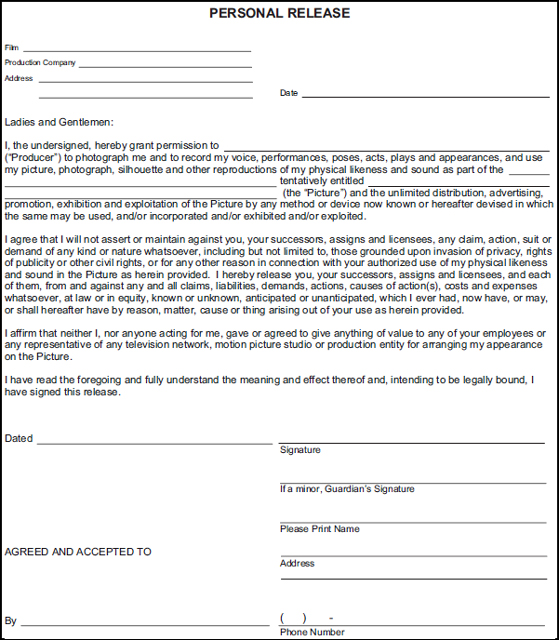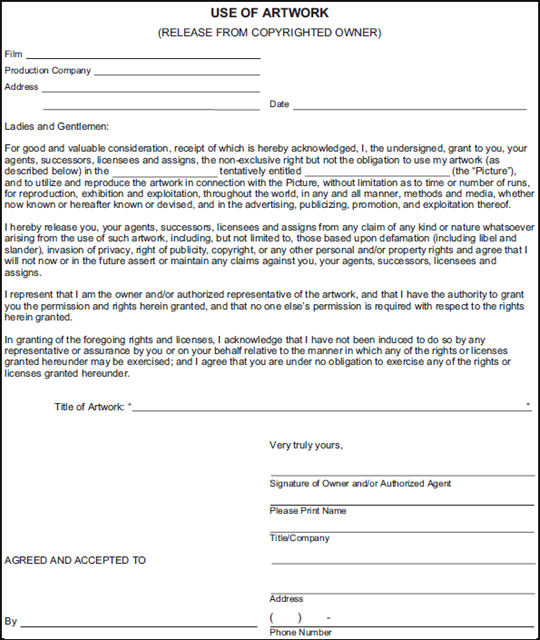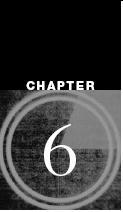Legal Release Forms
Applications
Considering the legal aspects of film production may be unpleasant, but a very necessary evil. Even if you’re making a short film, you need to protect yourself legally regarding any work or film materials that appears within the movie. Legal forms are even more critical if you’re even considering any type of distribution. Guerilla filmmakers ignore legal safeguards at their own peril.
Since your budget is probably limited, you can’t expect to have a high-profile attorney making sure that each step of film production is legally protected. Instead, be sure that you have a basic level of legal shelter. This means having basic documents that give you permission to film at a location, incorporate acting performances into your film, and use works of art (such as a musical soundtrack) in your production.
The following three releases have been included thanks to Eve Light Honthaner. She has written a valuable book named “The Complete Film Production Handbook” (ISBN 0-240-80419-8). The book includes legal forms, reference materials for producers and production managers, in-depth examination of film planning, basic accounting procedures, sample breakdowns and schedules, and lots more information. It’s a must-have if you’re participating in the logistics of production.
Because I think you’ll find information in the handbook that you won’t find anywhere else, I’ve included an abbreviated table of contents here:
• The production team and who does what;
• Basic accounting;
• From script to schedule;
• Pre-production;
• Insurance requirements;
• Making good deals and saving money;
• Deal memos;
• Unions and guilds;
• Principal talent and extras;
• Clearances and releases;
• Locations and foreign locations;
• Industry survival tips;
• Tear-out blank forms.
The first release, the Personal Release (see figure 6-1), grants permission to use an actor’s performance and likeness in your film. It’s critical that you gain this permission before any footage has been recorded. If you don’t obtain this permission in advance, the actor may have you over a barrel when you ask for it days into principal photography.
The Use of Artwork release (see figure 6-2) grants the rights to include a copyrighted work within your film. Be careful to understand the limits of this agreement. A copyright holder can only grant rights that he or she actually owns. Therefore, if a musician grants the rights to use a song he’s written and performed, yet the song includes samples to which no license has been obtained, he doesn’t have the right to grant the use of the song in your film.

A Location Release (see figure 6-3) is good to obtain as soon as a party agrees to allow you use of the location. Although getting this release is no guarantee that a location owner won’t renege at the last minute (this happens often, so be prepared with an alternate), a signed agreement has much more weight than a verbal guarantee. That said, once you obtain the location release, be sure to instill in your film crew respect for the location they’ll be using.

Suggestions
Here are a few suggestions to help you:
• Have releases signed well ahead of need People change their minds constantly. You don’t want to show up at a location on the day of the shoot and be denied clearance or be required to give an actor a better credit just to get his release signature. Your best friend may decide that you can’t use his soundtrack the week before the final cut is due. The unthinkable happens often in the movie business. Make sure you’re protected.
• Document location conditions When filming at a location, it’s important to document the condition of the site before you start filming there. I can’t tell you the number of times people have demanded cleaning and repair on conditions that existed before the film crew arrived. The one time I saw a location manager confronted with a Polaroid that contradicted his claims, he immediately withdrew his other illegitimate demands.
• Carefully weigh legal advice Lawyers are paid to make sure you’re completely protected, so they tend demand safeguards that may not be practical when things need to get done. It’s up to you to decide whether some unprotected risks are appropriate. I met a producer, trying to get a film made, who was partnered with a lawyer. The producer consulted the lawyer before making any moves. Needless to say, the movie they were trying to make never got past preproduction. Remember that in the end, you have to rely on your own judgment.


